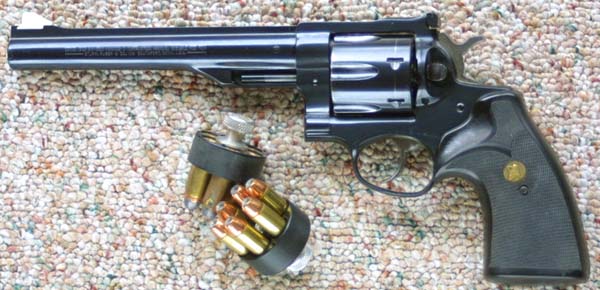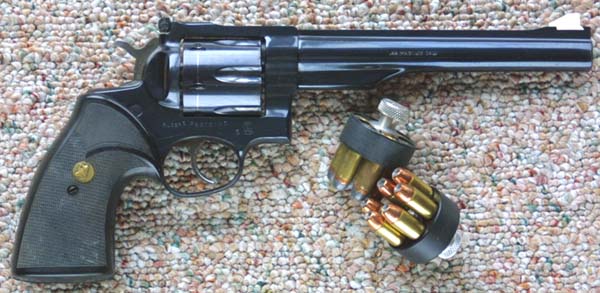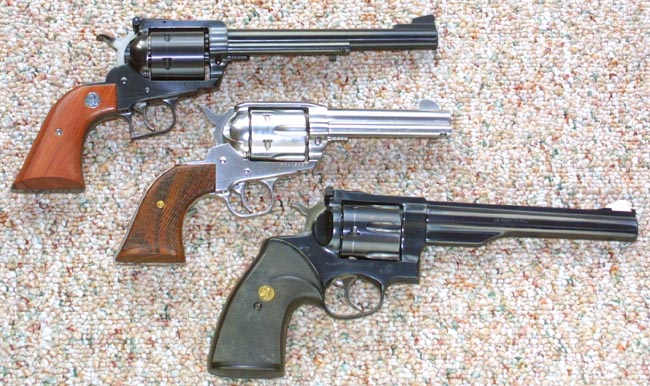 Ruger Redhawk
Ruger Redhawk
| Length overall | Barrel Length | Weight | Caliber | Action Type | Magazine Capacity |
| 13.5" | 7 ½ | 52oz. | .44 Magnum | D.A. Revolver | 6 |
 Magnum handgun of choice was still the S&W
Model 29, and most buyers still settled for the single action Ruger Super Blackhawk. Still, the Redhawk was
a double action 44 Magnum revolver, and was beginning to create quite a
following among firearms enthusiasts, particularly if they happened to be
handgun hunters. When, in my early twenties, I saw this gun sitting in the
display case, and at a price that I could afford, I was nearly ecstatic.
Magnum handgun of choice was still the S&W
Model 29, and most buyers still settled for the single action Ruger Super Blackhawk. Still, the Redhawk was
a double action 44 Magnum revolver, and was beginning to create quite a
following among firearms enthusiasts, particularly if they happened to be
handgun hunters. When, in my early twenties, I saw this gun sitting in the
display case, and at a price that I could afford, I was nearly ecstatic.The Redhawk, originally introduced in stainless steel, was a completely modern design, and was tailored, and proportioned to the use of the 44 Magnum. It was also designed as a hunting handgun, and was quite a bit stronger than the S&W M-29. In point of fact, the introduction of the Redhawk, along with that of the Dan Wesson, eventually moved S&W to enhance the M-29, adding what it called the Endurance package, in an attempt to bring the old Smith up to the strength level of some the newer guns.
The Ruger uses coil springs, and has a more modular design than that of the S&W N frame, which lends itself to CNC production. It is considerably less labor intensive to produce than the N frame Smith. The double action trigger of the Ruger is lighter than that of the Smith; but does not seem to have the same crispness, at least to my perceptions. The same holds true for the single action pull, though to a lesser extent. I somewhat prefer that of the Smith; but this may simply be a matter of what I am used to, and at any rate is a personal preference. The point being made here is that there is a somewhat different feel to the trigger pull. The trigger itself is wide, curved, and smooth, without the grooves which are commonly found on the S&W triggers.
The gun shoots great. My double action groups are a bit tighter, than those I can shoot with the big Smith, though my single action scores tend to be better with the old Model 29. This may be due to the greater weight of the Ruger, the slightly different trigger pull, or the different design of the trigger itself. I would be hard pressed to choose one over the other. I suppose for target work, I would go with the Model 29, while for use in the field I would choose the Redhawk. In truth, I get far more use from my Model 629; but this is in no way meant to slight the big Ruger. The Redhawk is a great gun, and for several years, it was the only 44 Magnum that I owned. The 7.5" barrel is such a good all around length, that it is now offered by S&W, and is the only length available on several of their current N frame offerings. Years after having acquired a brace of S&W 44 Magnums, in all three common barrel lengths, I have never seen the need to part with my Ruger Redhawk.
The blue on this particular example is a deep, almost black color, and has worn surprisingly well over the more than twenty years that I have owned this gun. The fit and finish are very good, though the gun is far from being as fancy as the deluxe offerings from S&W. The sights are excellent, though this particular gun is cursed with a white plastic insert, which I really dislike. The inserts are easy to change, however, and it is just laziness which has allowed the white front blade to remain in place for so long. The rear sight is click adjustable for windage and elevation. The top is smooth and flat, making a great platform for mounting a scope, or a red dot sight. The top of the barrel is wide, and grooved, to make for a good sighting plane, and to help cut down on glare. The cylinder is not counterbored, a trait it holds in common with the post 1981 S&W Revolvers.
The Ruger is a noticeably bulkier gun than the Model 29. This extra bulk was designed into the gun to make it strong enough to digest a steady diet of 300 grain, and heavier, bullets. These heavy bullets, and the large powder charges which propelled them, were created by silhouette shooters, who needed the extra power to knock down metal rams at long distances. Such loads were never conceived of when the original 44 Magnum was introduced in 1955, and were certainly never considered when the original N framed hand ejector was created in 1907. In it's nearly hundred years of production, the N frame has certainly been taken to places that would have had it's designers marveling. Where might the Ruger, and the new S&W X frame guns be taken in the next seventy or 100 years?
Bill Ruger designed and produced some of the most popular service and sporting arms in the country. He had always excelled at making handy firearms designed for
When the Dirty Harry movies ignited a demand for the previously special purpose M-29 .44 Magnum, Bill Ruger, again saw an opening in the market. The S&W magnums began as an outgrowth of some handloaders experimentation. At the early part of this century when smokeless powder was taking over from black powder, most of the cartridges were (and are) much larger than they need to be. The best example of this is the .45 Long colt which, filled with black powder, has the same level of power as the much shorter .45 A.C.P., which was designed and loaded from the start with smokeless powder. The larger black powder vintage rounds would be given smaller charges of the new smokeless powder. These mostly empty cases would produce the same energy levels as if they were fully loaded with black powder. It takes no genius to figure out that some intrepid handloaders would begin fill those large cases with the new smokeless powder. Some experimental handloads produced in .38 Special cases would lead to the .357 Magnum cartridge. This cartridge appeared in the late 1920's in the model 38/44, the predecessor of the M-27 pistol, which was produced through the nineties. The gun was initially produced with a 8 3/8 " barrel to make full use of the slower burning powders and develop maximum velocity. It was considered to be a hunting piece, and a premium prestige gun. The original loads had been done using standard .38 cases, but it was thought for safeties sake, to make the cases 1/8 of an inch longer in order to prevent them from being used in guns which were not designed for them. In the fifties history was to repeat itself, Elmer Keith, and others, worked up handloads for the .44 Special. This round would develop into the .44 Magnum, again a special load and gun for hunters.
These guns had certain following, but were by no means best sellers; then came Dirty Harry. Suddenly, every one wanted a .44 Magnum, and there were relatively
By 1978, Ruger announced the new Redhawk pistol, a double action revolver using new production techniques, chambered for the .44 Magnum, and priced right. This is a larger, heavier, and stronger gun than he M-29. It has a very smooth, light trigger pull which contributes to it's great accuracy. With a light load, I can shoot two inch groups with this gun at 25 yards, with full power loads this opens up to about three inches. The top of the barrel has a solid rib which makes a fine sighting platform, and adds to the stability of the gun. The Smith gun seems more elegant and fragile by comparison, making the big Ruger seem somewhat brutish. Ruger has introduced an even larger version called the Super Redhawk, which has a larger frame and is designed to have a scope mounted on it.
 The design of the Redhawk, in common with that of the
now discontinued Security Six, was clearly influenced by that of the venerable
Blackhawk single action. The sights are nearly identical, as is the flat
topstrap. The hammer, and the rear of the frame also both curve outwards,
in the single action style of the Blackhawk, rather than inwards as is the
case in the S&W double action. Also in common with the Ruger single action
series, the Redhawk uses coils springs. It is also able, in common with it's
single action brethren, to take loads which are slightly hotter than the
standard 44 Magnum.
The design of the Redhawk, in common with that of the
now discontinued Security Six, was clearly influenced by that of the venerable
Blackhawk single action. The sights are nearly identical, as is the flat
topstrap. The hammer, and the rear of the frame also both curve outwards,
in the single action style of the Blackhawk, rather than inwards as is the
case in the S&W double action. Also in common with the Ruger single action
series, the Redhawk uses coils springs. It is also able, in common with it's
single action brethren, to take loads which are slightly hotter than the
standard 44 Magnum.